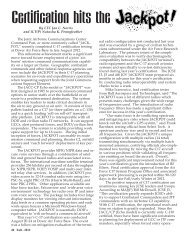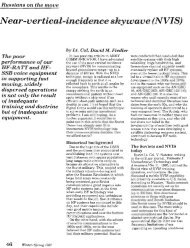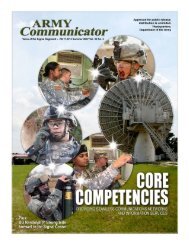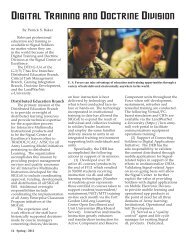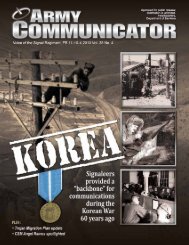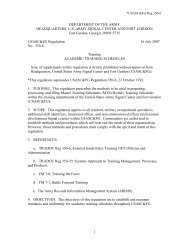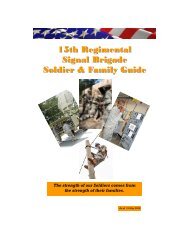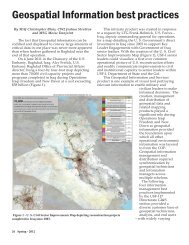AC Summer 08 WIN-T Online - United States Army Signal Center of ...
AC Summer 08 WIN-T Online - United States Army Signal Center of ...
AC Summer 08 WIN-T Online - United States Army Signal Center of ...
Create successful ePaper yourself
Turn your PDF publications into a flip-book with our unique Google optimized e-Paper software.
NSCs enable<br />
Expeditionary information<br />
“In modern conflict,<br />
information has become as<br />
important as lethal action<br />
in determining the outcome<br />
<strong>of</strong> operations.”<br />
FM 3-0, Operations, Feb 20<strong>08</strong><br />
By Ge<strong>of</strong>frey Wells<br />
It’s all about information<br />
The newly published FM 3-<br />
0, Operations, describes combat<br />
power as “…the total means<br />
<strong>of</strong> destructive, constructive,<br />
and information<br />
capabilities that a<br />
military unit/formation<br />
can apply at a given<br />
time.” The manual<br />
notes that the<br />
warfighting functions<br />
comprising combat<br />
power—movement and<br />
maneuver, intelligence,<br />
fires, sustainment, command<br />
and control, and protection—are<br />
“multiplied by leadership<br />
and complemented by information.”<br />
The graphic in the manual,<br />
shown below, reinforces the fact that<br />
information is essential to the<br />
successful execution <strong>of</strong> all<br />
warfighting functions, giving<br />
commanders the ability to understand,<br />
visualize, describe, and direct<br />
warfighting activities, and make<br />
informed decisions that effectively<br />
apply combat power.<br />
To generate combat power,<br />
commanders <strong>of</strong> expeditionary <strong>Army</strong><br />
units must have access to global<br />
information resources and the ability<br />
to quickly and securely exchange<br />
large amounts <strong>of</strong> information with<br />
modular forces located around the<br />
world. This capability must be<br />
available through all phases <strong>of</strong> an<br />
operation to enable planning and<br />
coordination with assigned forces<br />
that may be widely dispersed, to<br />
facilitate distributed training and<br />
rehearsal, and to enhance common<br />
operational awareness. The capability<br />
must extend across the full<br />
expanse <strong>of</strong> the enterprise, from the<br />
deployed force to the generating<br />
force, so commanders have access to<br />
information resources beyond the<br />
limits <strong>of</strong> their immediate area <strong>of</strong><br />
operation. Properly configured,<br />
Figure 1<br />
such a capability can give expeditionary<br />
forces the ability to deploy<br />
rapidly, immediately enter the fight,<br />
dynamically change task organization,<br />
and maintain command and<br />
control as forces maneuver and<br />
command posts relocate. Creating<br />
that capability—making information<br />
“expeditionary”—is the challenge<br />
addressed in the <strong>Signal</strong> <strong>Center</strong>’s<br />
Network Service <strong>Center</strong> concept.<br />
What a Network Service <strong>Center</strong><br />
is… and isn’t<br />
Although it sounds like a place,<br />
a Network Service <strong>Center</strong> is really a<br />
combination <strong>of</strong> capabilities that<br />
connect warfighters to an array <strong>of</strong><br />
network services. The basic capabilities—transport,<br />
information services,<br />
and network operations—can be<br />
found at almost every echelon <strong>of</strong> the<br />
<strong>Army</strong> and in many forms; however,<br />
the Network Service <strong>Center</strong> concept<br />
focuses on capabilities that connect<br />
warfighters to global network<br />
services at the regional level.<br />
Regional NSCs merge the<br />
capabilities <strong>of</strong> regional hub nodes,<br />
area processing centers, and theater<br />
network operations and security<br />
centers to integrate and precondition<br />
theater network<br />
services. RHNs are satellite<br />
earth terminals that have<br />
the capacity <strong>of</strong> three<br />
tactical hub nodes.<br />
RHNs collocate with<br />
Defense Information<br />
Systems Network gateway<br />
sites to provide the<br />
expeditionary force<br />
points <strong>of</strong> entry into the<br />
global network. APCs,<br />
commonly located with<br />
Defense Enterprise Computing<br />
<strong>Center</strong>s, provide information<br />
services and can host battle command<br />
and other applications to<br />
support the deployed force.<br />
TNOSCs serve as the NSCs’ management<br />
component, coordinating and<br />
synchronizing the provisioning <strong>of</strong><br />
network resources, protecting the<br />
network, and staging information to<br />
meet the needs <strong>of</strong> the operational<br />
commander.<br />
Strategically positioned around<br />
the world, regional NSC’s will<br />
establish an “always on” backbone<br />
network that will allow expeditionary<br />
warfighters to quickly transition<br />
from garrison to combat operations.<br />
See Figure 2.<br />
Connecting the deployed force<br />
In operation, NSCs will enable<br />
units to deploy rapidly without<br />
having to pre-position an organic<br />
hub node. Network services will be<br />
available as soon as units establish a<br />
<strong>Army</strong> Communicator 63



